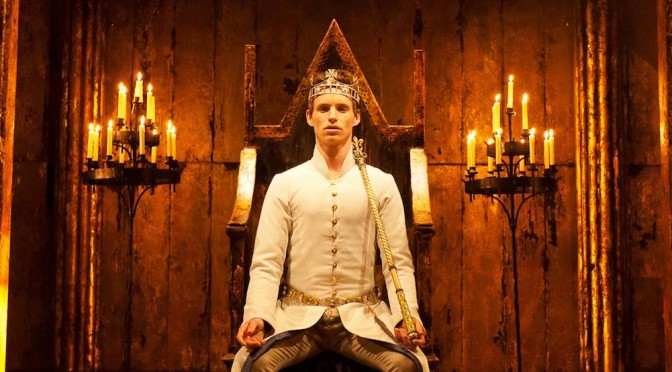Richard as Holy Roman Emporer
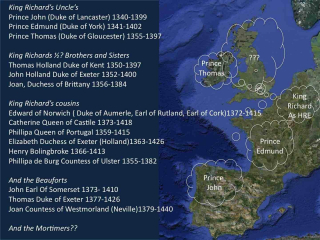
Richard’s handing of the Peasants revolt was firm but considerate. A scheme was developed for him to become Holy Roman Emperor.
He married Anne of Bohemia who was both the daughter and sister of a Holy Roman Emperor. She and her advisors were most impressed with the teachings of John Whycliffe, who was promoted at court by John of Gaunt and Alyse Perrers which were carried back to Bohemia and inspired the Hussite movement which matured to cover most of Eastern Europe.
It must be assumed therefore that these initiatives intended to limit the powers of the church of rome were compatible with the ambitions of the empire or at least the Emperors from Anne’s family.
However Richard’s submission was rejected by the electors, who cited his failure to retain his French possessions and his failure to gain control of Ireland as evidence of weakness which would make him unsuitable for the highest office.
Richards strategy, and it does seem to have been a personal strategy to overcome these objectives was to reach an honourable settlement in France and to pursue the “Question of Ireland” with more vigour. However his solution in Ireland was not outright aggression but to seek the submission of the Irish clans and English settlers as their overlord ( High King ??) but to leave them essentially autonomous.
A question which is rarely asked is; if Richard was to depart to a new life as Holy Roman Emperor who would have become King of England? The answer must be, can only be, John of Gaunt., opening the prospect of succession open to Henry Bolingbroke.
It is quite possible that the strategy was designed by Gaunt for the benefit of Gaunt after the failure of his bid to become King of Castile
Personal Crisis
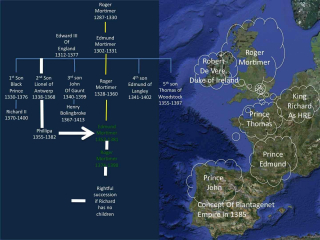 In the meantime King Richard suffering a personal crisis. Richards mother Joan died in 1385, and Richard’s first wife Anne of Bohemia, for whom he had a great affection and relied on for advice and encouragement died in 1294. In 1296. Richard married Isabelle de Valois who was only six years of age. This deprived Richard of the intimate female support he had enjoyed all of his life.
In the meantime King Richard suffering a personal crisis. Richards mother Joan died in 1385, and Richard’s first wife Anne of Bohemia, for whom he had a great affection and relied on for advice and encouragement died in 1294. In 1296. Richard married Isabelle de Valois who was only six years of age. This deprived Richard of the intimate female support he had enjoyed all of his life.
He fell back on his association with Alice Perrers who persuaded Richard to confirm Roger Mortimer, son of Phillipa of Ulster and Edmund Mortimer as the heir to the throne if he should die before his child bride was old enough to concieve.
It was in this period he developed a strong affinity for Robert de Vere, who he decided was just the man to handle the Irish initiative. He made Robert Marquis of Dublin and then Duke of Ireland, the first time someone outside the royal family had been given the title of Duke.
King of Castile
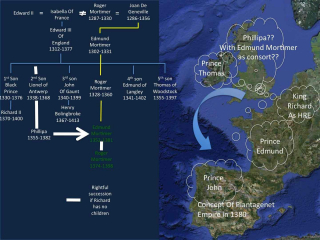 Gaunt’s marriage to Constance Pedra, eldest surviving child of Pedro of Castile (Peter the Cruel, or alternatively “El Jusifario”), produced a daughter, Katherine. In 1386 Gaunt left England for Castile, which then was more than half of what is now Spain, to pursue by force Constance’s claim to the throne of Castile. This was in itself problematical. Constance was the daughter of Maria Juana de Pedilla, the mistress, not the wife of Pedro and therefore was illigitimate. English records persist in claiming that Pedro and Maria did marry, but Spanish records are equally adamant that the did not. In Spain Constance is known as Constance de Pedilla.
Gaunt’s marriage to Constance Pedra, eldest surviving child of Pedro of Castile (Peter the Cruel, or alternatively “El Jusifario”), produced a daughter, Katherine. In 1386 Gaunt left England for Castile, which then was more than half of what is now Spain, to pursue by force Constance’s claim to the throne of Castile. This was in itself problematical. Constance was the daughter of Maria Juana de Pedilla, the mistress, not the wife of Pedro and therefore was illigitimate. English records persist in claiming that Pedro and Maria did marry, but Spanish records are equally adamant that the did not. In Spain Constance is known as Constance de Pedilla.
Despite this, it was perhaps not an unreasonable claim to pursue, as the alternative aspirant to the throne of Castile, John de Trastamara’s own father Enrique de Trastamara, was himself illegitimate.
Henry Bolingbroke
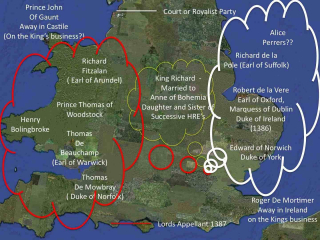 In John of Gaunt’ absence his son Henry (of) Bolingbroke, only four years older than Richard, considered it his right to assume the role of mentor of Richard, which his father had relinquished.
In John of Gaunt’ absence his son Henry (of) Bolingbroke, only four years older than Richard, considered it his right to assume the role of mentor of Richard, which his father had relinquished.
Richard resented this intrusion and gathered his own group of councillors around him.
The wars commence
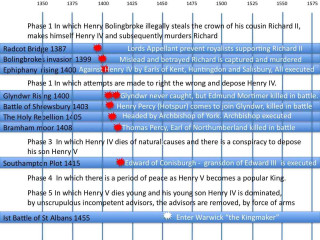
In an armed rebellion Henry Bolingbroke and other senior nobles defeated the Kings army which had been under the command of Robert De Vere.
Bolingbroke used the ensuing peace to appeal to parliament that the members of the kings council had exerted undue influence over him and were guilty of treason. Those who made the appeal to parliament became known as the “Lords Appellant”.
In this way the techniques of Alice Perrers were turned against her. Her power was broken and she vanished from the public scene. However she fared better than other members of the King’s council.
Several were executed and the Earl of Suffolk and the Duke of Ireland fled to France. They were sentenced to death in their absence and never returned.
Bolingbroke Exiled

John of Gaunt returned from Spain in 1389 and again assumed control over his son and the King, brokering a reconciliation between them. Richard grew to adulthood and plotted his revenge. His opportunity came in 1398 when Thomas Mowbray, Duke of Norfolk, who had been another member of the Lords Appellant, accused Henry Bolingbroke of Treason. Bolingbroke refuted the accusation and accused Mowbray of the same offence. It was for Richard the perfect opportunity. Both his enemies, now accusing each other of treason. Richard decided to judge the case away from parliament and the Duke of Aumerle demanded trial by combat, accuser against accuser, revenge indeed!
At the last minute however Richard changed his mind and sent them both into exile.
Richard Murdered
The initiating incident was that Henry Bolingbroke, who in 1400 was third in line to the throne, declared that he had a better claim to the throne than even the encumbant, Richard II. Shakespeare’s play indicates that Richard was an extravagant, wasteful king preoccupied with fashion, sliding towards paranoia and despotism. Henry had, according to Shakespeare no alternative but to “save” the country by deposing Richard. In Shakespear’s version he did not order Richard’s death and when he learned of it swore to make reparation by going on a pilgramage.
Until quite recently the majority of students studied Shakespeare at secondary school and so this story has become widely accepted as history.
Recent opinion has swung against Henry Bolingbroke and regards him and his Lancastrian successors as usurpers of the throne. Nevertheless investigation of his claim and the subsequent Tudor claim shows that the claim, if not the means of pursuing the claim, cannot be dismissed out of hand.
